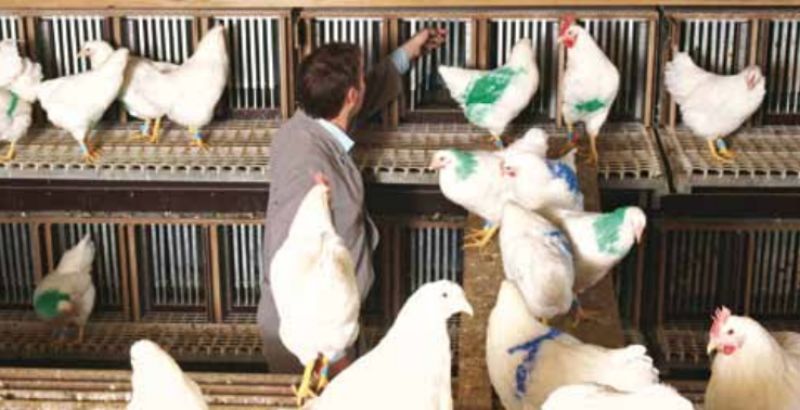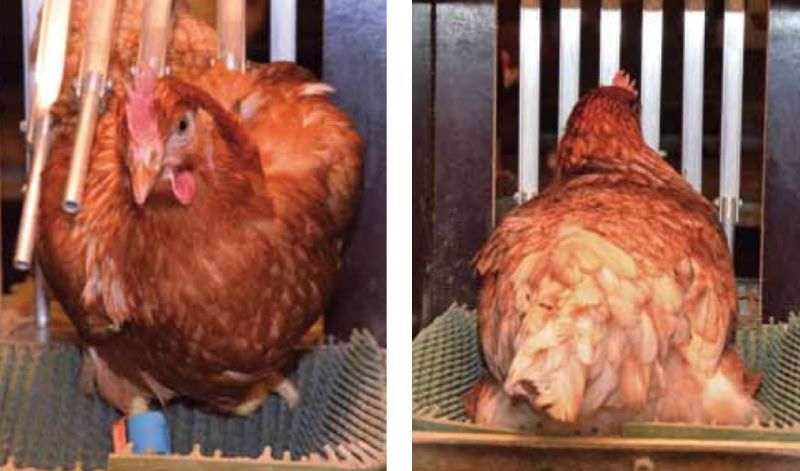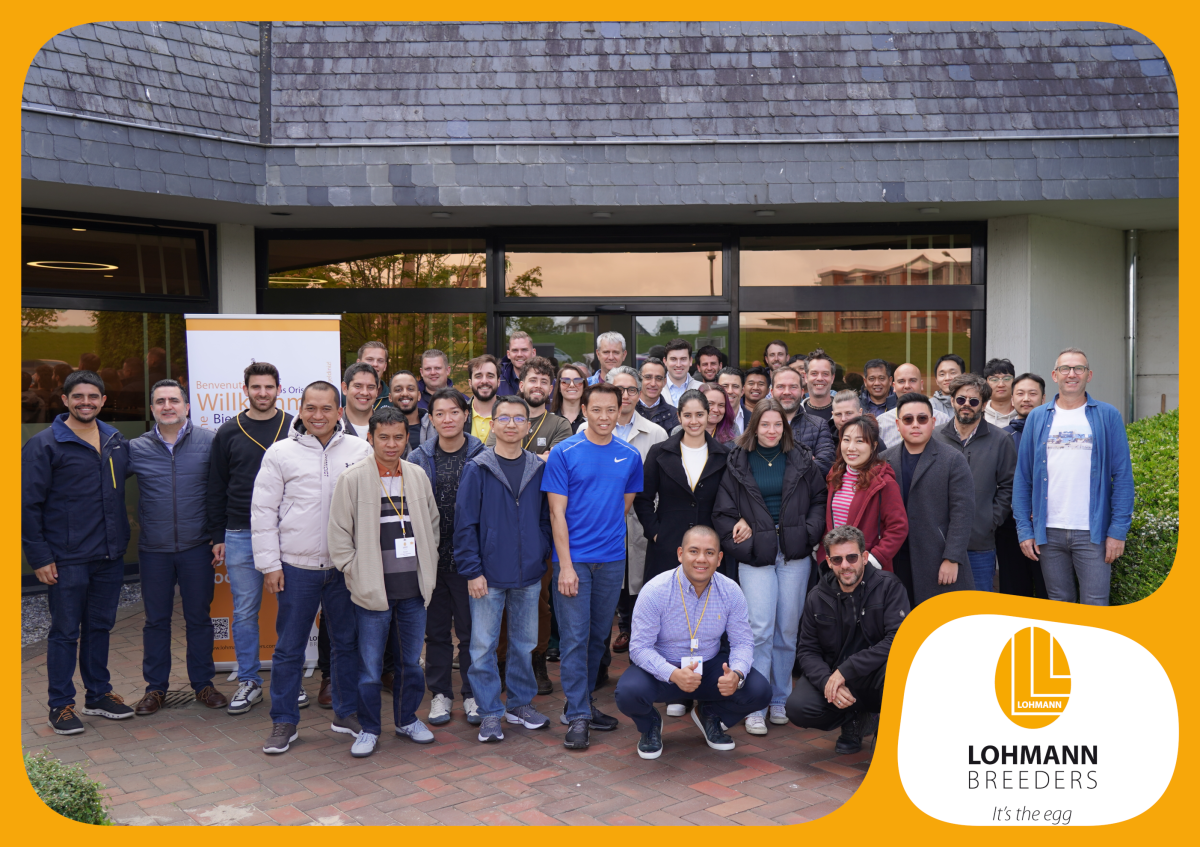In which direction is layer breeding heading in major areas? LOHMANN
TIERZUCHT’s geneticists Prof. Dr. Rudolf Preisinger and Dr. Wiebke Icken give
clear answers to seven current questions.
 1. Are there differences in the breeding
of layers determined for barn and free
range systems?
1. Are there differences in the breeding
of layers determined for barn and free
range systems?
LOHMANN TIERZUCHT continues to focus its activities on the essential characteristics such as high laying performance, good feed conversion, market compliant egg weight as well as excellent shell and egg quality. However, in these management systems, the behaviour of the hens is of higher importance than in cage systems.
The particular suitability for barn and free range systems comprises of characteristics such as stability of plumage, low tendency for feather pecking and cannibalism, spreading in the house system, good usage of free range and nest acceptance, meaning less floor eggs. Additionally, hens in barn and free range systems have to cope with greater environmental and stress influences and in case of suboptimal feeding, have to show high metabolic stability.
2. How can the behavioural characteristics mentioned above be monitored in breeding work?
Reliable data obtained from an environment which is similar to practical farming conditions, are an indispensable precondition. This means that the hens monitored must be managed in large groups, but nevertheless the performance and behaviour of each individual hen can be analysed.
At LOHMANN TIERZUCHT, performance and behavioural data are recorded with the aid of the so-called Weihenstephan Funnel Box based on transponder technology. This enables the automatic and individual recording of nest visits, nest occupation time, oviposition time and number of eggs. Due to the transponders ensuring the identification of each single laying hen, the period of time spent in the free range can also be logged.
3. Is the heritability of behavioural characteristics high enough for successful breeding?
Eggs which are laid on the floor will not be taken into account as being saleable eggs, thus reducing the laying performance.. The heritability lies on a mid-range level and thus, can be well treated in breeding. The heritability estimates of free-range usage also lies on the mid-range level. However, it correlates negatively to the laying performance – hens showing a high laying performance spend less time in the free-range area.
4. To which extent does house management influence the hens’ behaviour?
Training and management decisively influence nest acceptance. Fostering the hens’ activity by means of a corresponding rearing, a timely house change into the production house as well as the design and arrangement of the laying nests are among the most important aspects in order to minimize the number of floor eggs. To a great extent, feather pecking and cannibalism depend on the house management. Here, principal starting points are the choice of lighting, an adapted lighting programme and feeding in line with demand.
5. What are the main differences between white and brown hens, especially in terms of their suitability for alternative management?
The behaviour of white and brown laying hens is considerably different. While the white Leghorn hen seems to beanxious and hectic, the brown hen is characterized by a calmer and calm behaviour, which sometimes even affects the nest acceptance negatively. Results obtained by the Weihenstephan Funnel Box have shown that compared to the LOHMANN LSL hen, the LOHMANN BROWN hen starts earlier in the day with oviposition. Furthermore, LOHMANN LSL hens spend a much shorter period of time while visiting nests during the day and stay notably longer in the nest per visit.
For management purposes, it can be deduced from these results, a stock of LOHMANN LSL hens having the same size as one of LOHMANN BROWN hens, should be provided with more nest spaces in order to avoid floor eggs. In optimum management, both hens are equally suitable for alternative systems. The decisive factors for choosing the right hen are the national market situation and the consumers’ preferences.
6. Can a worldwide operating company such as LOHMANN TIERZUCHT meet the different requirements for laying hens?
Basically, the different selection criteria are integrated in an overall breeding value index. This index evaluates the single criteria with regard to their controllability through breeding as well as their economic and market relevant importance.
LOHMANN TIERZUCHT offers five basic pedigrees of which the single selection criteria are prioritised differently. Lets take for example, a robust, brown-feathered hen with relatively big eggs the LOHMANN TRADITION. Unlike the LOHMANN BROWN hen, she has a lower egg rate and higher feed consumption.
The individual countries of the world focus on different criteria. Japan, a country in which eggs are also eaten raw, has the highest demands where egg quality is concerned. Canada would like to have white eggs whereas. Spain prefers having brown eggs and eggs which are as big as possible. India is a market for small, white-coloured eggs. Cream-coloured eggs are also very popular in Japan and China, whereas these eggs are not saleable in Europe. Last but not also least, hens have to prove themselves in the most various climatic regions worldwide and under differing management conditions.

7. To what extent have new, geneticbased breeding methods been already integrated in layer breeding?
At the moment, intensive research is being carried out in terms of marker-assisted selection, for example, as part of the project Synbreed, in which LOHMANN TIERZUCHT is also involved. Marker-assisted selection aims at analysing several patches of the genome for small differences, which when combined, can provide an indication of performance respective of important breeding criteria. In the meantime, research
has already identified 600,000 chicken markers. However, a single patch can at the same time have a positive effect on one characteristic and a negative on another. When it comes to performance and quality criteria, the combination of all patches provides the genetic predisposition.
In conducting blood sample analysis, marker-assisted selection will facilitate the selection of males and hens already during rearing. Thus, a first selection without efficiency testing can be carried out earlier and more targeted, which again shortens the generation interval and increases the breeding progress. In addition, selection will become more efficient where vitality and susceptibility to diseases are concerned.
A successful example for the use of genetic analysis in layer breeding is the exclusion of the “genetic defect for fishy egg” tainting brown layer lines.” LOHMANN TIERZUCHT owns the European patent for this.

 1. Are there differences in the breeding
of layers determined for barn and free
range systems?
1. Are there differences in the breeding
of layers determined for barn and free
range systems? LOHMANN TIERZUCHT continues to focus its activities on the essential characteristics such as high laying performance, good feed conversion, market compliant egg weight as well as excellent shell and egg quality. However, in these management systems, the behaviour of the hens is of higher importance than in cage systems.
The particular suitability for barn and free range systems comprises of characteristics such as stability of plumage, low tendency for feather pecking and cannibalism, spreading in the house system, good usage of free range and nest acceptance, meaning less floor eggs. Additionally, hens in barn and free range systems have to cope with greater environmental and stress influences and in case of suboptimal feeding, have to show high metabolic stability.
2. How can the behavioural characteristics mentioned above be monitored in breeding work?
Reliable data obtained from an environment which is similar to practical farming conditions, are an indispensable precondition. This means that the hens monitored must be managed in large groups, but nevertheless the performance and behaviour of each individual hen can be analysed.
At LOHMANN TIERZUCHT, performance and behavioural data are recorded with the aid of the so-called Weihenstephan Funnel Box based on transponder technology. This enables the automatic and individual recording of nest visits, nest occupation time, oviposition time and number of eggs. Due to the transponders ensuring the identification of each single laying hen, the period of time spent in the free range can also be logged.
3. Is the heritability of behavioural characteristics high enough for successful breeding?
The characteristics nest acceptance and laying performance are recorded with the Weihenstephan Funnel Box in the common selection criterion “Number of saleable nest eggs”
Eggs which are laid on the floor will not be taken into account as being saleable eggs, thus reducing the laying performance.. The heritability lies on a mid-range level and thus, can be well treated in breeding. The heritability estimates of free-range usage also lies on the mid-range level. However, it correlates negatively to the laying performance – hens showing a high laying performance spend less time in the free-range area.
4. To which extent does house management influence the hens’ behaviour?
Training and management decisively influence nest acceptance. Fostering the hens’ activity by means of a corresponding rearing, a timely house change into the production house as well as the design and arrangement of the laying nests are among the most important aspects in order to minimize the number of floor eggs. To a great extent, feather pecking and cannibalism depend on the house management. Here, principal starting points are the choice of lighting, an adapted lighting programme and feeding in line with demand.
5. What are the main differences between white and brown hens, especially in terms of their suitability for alternative management?
The behaviour of white and brown laying hens is considerably different. While the white Leghorn hen seems to beanxious and hectic, the brown hen is characterized by a calmer and calm behaviour, which sometimes even affects the nest acceptance negatively. Results obtained by the Weihenstephan Funnel Box have shown that compared to the LOHMANN LSL hen, the LOHMANN BROWN hen starts earlier in the day with oviposition. Furthermore, LOHMANN LSL hens spend a much shorter period of time while visiting nests during the day and stay notably longer in the nest per visit.
For management purposes, it can be deduced from these results, a stock of LOHMANN LSL hens having the same size as one of LOHMANN BROWN hens, should be provided with more nest spaces in order to avoid floor eggs. In optimum management, both hens are equally suitable for alternative systems. The decisive factors for choosing the right hen are the national market situation and the consumers’ preferences.
6. Can a worldwide operating company such as LOHMANN TIERZUCHT meet the different requirements for laying hens?
Basically, the different selection criteria are integrated in an overall breeding value index. This index evaluates the single criteria with regard to their controllability through breeding as well as their economic and market relevant importance.
LOHMANN TIERZUCHT offers five basic pedigrees of which the single selection criteria are prioritised differently. Lets take for example, a robust, brown-feathered hen with relatively big eggs the LOHMANN TRADITION. Unlike the LOHMANN BROWN hen, she has a lower egg rate and higher feed consumption.
The individual countries of the world focus on different criteria. Japan, a country in which eggs are also eaten raw, has the highest demands where egg quality is concerned. Canada would like to have white eggs whereas. Spain prefers having brown eggs and eggs which are as big as possible. India is a market for small, white-coloured eggs. Cream-coloured eggs are also very popular in Japan and China, whereas these eggs are not saleable in Europe. Last but not also least, hens have to prove themselves in the most various climatic regions worldwide and under differing management conditions.

7. To what extent have new, geneticbased breeding methods been already integrated in layer breeding?
At the moment, intensive research is being carried out in terms of marker-assisted selection, for example, as part of the project Synbreed, in which LOHMANN TIERZUCHT is also involved. Marker-assisted selection aims at analysing several patches of the genome for small differences, which when combined, can provide an indication of performance respective of important breeding criteria. In the meantime, research
has already identified 600,000 chicken markers. However, a single patch can at the same time have a positive effect on one characteristic and a negative on another. When it comes to performance and quality criteria, the combination of all patches provides the genetic predisposition.
In conducting blood sample analysis, marker-assisted selection will facilitate the selection of males and hens already during rearing. Thus, a first selection without efficiency testing can be carried out earlier and more targeted, which again shortens the generation interval and increases the breeding progress. In addition, selection will become more efficient where vitality and susceptibility to diseases are concerned.
A successful example for the use of genetic analysis in layer breeding is the exclusion of the “genetic defect for fishy egg” tainting brown layer lines.” LOHMANN TIERZUCHT owns the European patent for this.








